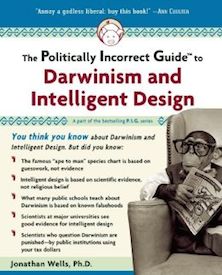The Politically Incorrect Guide™ to Darwinism and Intelligent Design
Exclusive hardcover edition — not available in stores!
In the 1925 Scopes trial, the American Civil Liberties Union sued to allow the teaching of Darwin’s theory of evolution in public schools. Seventy-five years later, in Kitzmiller v. Dover, the ACLU sued to prevent the teaching of an alternative to Darwin’s theory known as “Intelligent Design” — and won. Why did the ACLU turn from defending the free-speech rights of Darwinists to silencing their opponents? In “The Politically Incorrect Guide™ to Darwinism and Intelligent Design,” Jonathan Wells, Ph.D., reveals that, for today’s Darwinists, there may be no other choice: unable to fend off growing challenges from scientists, or to compete with rival theories better adapted to the latest evidence, Darwinism – like Marxism and Freudianism before it — is simply unfit to survive.
Dr. Wells, a biologist and senior fellow at the Discovery Institute, begins by explaining the basic tenets of Darwinism, and the evidence both for and against it. He reveals, for instance, that the fossil record, which according to Darwin should be teeming with “transitional” fossils showing the development of one species to the next, so far hasn’t produced a single incontestable example. On the other hand, certain well-documented aspects of the fossil record – such as the “Cambrian Explosion,” in which innumerable new species suddenly appeared fully formed — directly contradict Darwin’s theory. Wells also shows how most of the other “evidence” for evolution — including textbook “icons” such as Peppered Moths, Darwin’s Finches, Haeckel’s Embryos, and the Tree of Life — has been exaggerated, distorted . . . and even faked.
Wells then turns to the theory of Intelligent Design (ID), the idea that some features of the natural world, such as the internal machinery of cells, are too “irreducibly complex” to have resulted from unguided natural processes alone. In clear-cut layman’s language, he reveals the growing evidence for ID coming out of scientific specialties from microbiology to astrophysics. And he explains why, since ID is not based on the Bible or religious doctrines, and doesn’t draw any conclusions about who (or what) is the cause of design in nature, it is not a form of Biblical creationism or natural theology.
But religion does play a role in the debate over Darwin — though not the way evolutionists claim. Wells (who holds doctorates in biology and theology) shows how Darwin reasoned that evolution is true because divine Creation “must” be false — a theological assumption oddly out of place in a scientific debate. In other words, Darwinists’ materialistic, atheistic assumptions rule out any theories but their own, and account for their willingness to explain away the evidence — or lack of it. (This hostility to religion may also explain the appeal of Darwinism, which from Darwin’s day down to our own been used to justify radical changes in moral norms in areas such as eugenics, abortion, and — in the case of Nazi Germany — even racial extermination.) Finally, Wells details how Darwinists have succeeded in imposing a government-supported monopoly on the biological sciences in this country — and how opponents of Darwinism are being driven from their careers by Darwinist heresy-hunters.
- The collapsing case for Darwinism — and the mounting case for Intelligent Design
- How, though Darwin is often credited with citing “overwhelming evidence” for his theory of natural selection, all he actually provided was “one or two imaginary illustrations” of how it might work
- Why many of Darwin’s contemporaries regarded the same data he cited as evidence, not of common ancestry, but of common design
- One pro-Darwin science writer who candidly admits that the chain of fossil ancestry is “a completely human invention created after the fact”
- How, despite centuries of artificial breeding and decades of experiments, no one has ever observed one species turn into another (“speciation”)
- Why most alleged instances of “observed” speciation are actually analyses of already existing species that show how speciation might occur — but never that it has
- Darwin vs. Darwin: how he conceded that his theory was contradicted by known evidence (or lack thereof), though he hoped later findings would vindicate him – which still hasn’t occurred after 150 years
- How Darwin’s “strongest single class of facts” — the early vertebrate embryos — shows the opposite of what he thought it showed
- The Cambrian Explosion — aka biology’s “Big Bang”: how it contradicts Darwin’s branching “Tree of Life”
- Word games Darwinists play (example: exploiting the diverse meanings of “evolution” to distract critics)
- How science textbooks continue to feature “evidence” for Darwinism that has long since been proven fraudulent
- “Nothing in biology makes sense except in the light of evolution,” one Darwinist claims. Then why were most major biological disciplines founded either before Darwin, or by scientists who rejected his theory?
- Why the clinical practice of medicine has no use for Darwinism, despite claims that it is impossible to practice medicine without applying its principles
- Evolutionary biologist: “Perhaps it would be easier, and in the long run more productive, to abandon the attempt to force the data . . . into the mold provided by Darwin”
- Modern microbiologist: “Throughout 150 years of the science of bacteriology, there is no evidence that one species of bacteria has changed into another”
- National Academy of Sciences member: “Darwin’s theory … serves no important role in guiding modern experimental biology. That branch of science simply makes no practical use of Darwin’s theory”
- How Darwin’s theory provided the pseudoscientific foundation for the Nazis’ racial extermination policies
- How Haeckel’s famous faked embryo drawings were widely used to promote abortion in late twentieth-century America by convincing people that human embryos were little more than fish
- How the most common definition of Intelligent Design in the news media is flatly incorrect
- How living cells — which Darwin thought were mere blobs of protoplasm — actually consist of countless molecular machines that have all the hallmarks of design
- How design can be inferred not only in living things but also in various features of the cosmos, such as gravity
- How the Earth itself seems uniquely designed not only for life, but also for scientific observation
- How Darwin changed the definition of “science” itself to mean providing materialistic explanations for everything
- How Darwinism is widely used in public education to discredit traditional Christianity and promote atheism
- How Darwinists have openly declared that they will destroy the careers of professors and students who criticize them or defend intelligent design — and they’re doing it
Tags: Jonathan Wells, The Politically Incorrect Guide to Darwinism and Intelligent Design
- The Author

Jonathan Wells
Forty-five years ago, Jonathan Wells was a geology and biology student—and a Darwinist. Then he dropped out of school to […] More about Jonathan Wells.
- Books by the Author
Ratings Details














